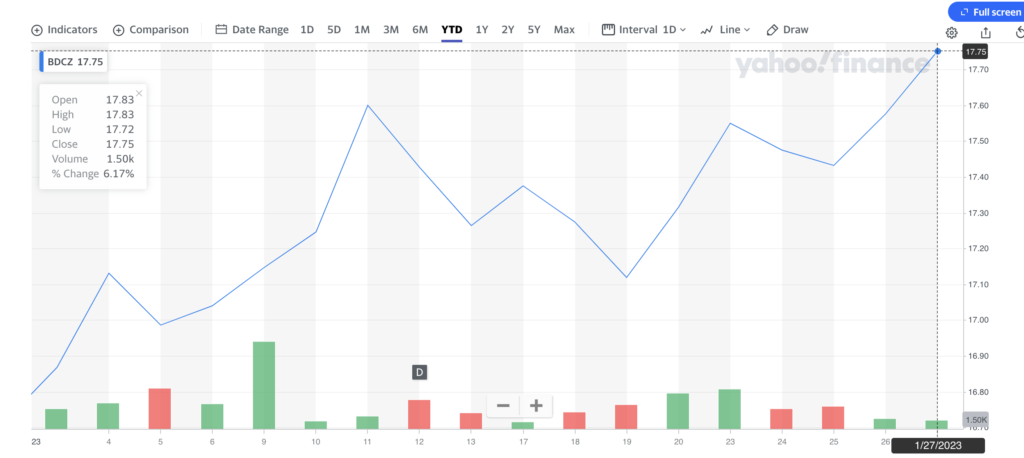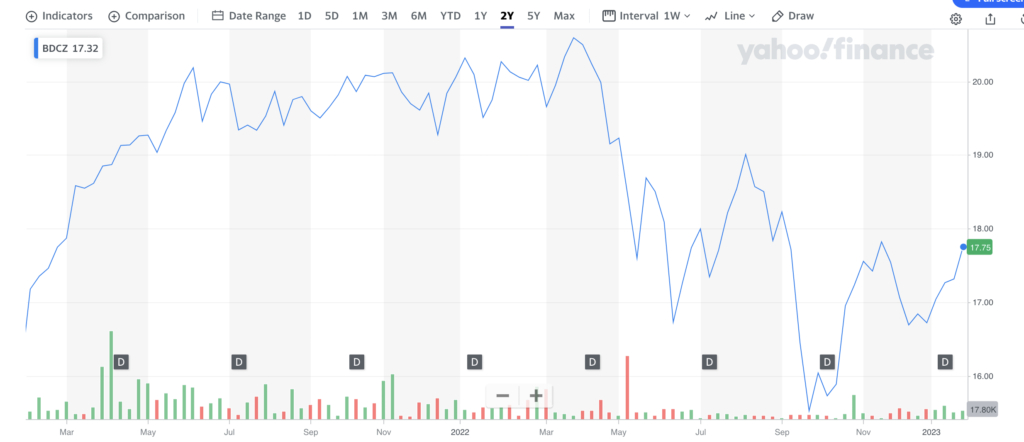BDC Common Stocks Market Recap: Week Ended January 27, 2023
BDC COMMON STOCKS
Week 4
The BDC rally is picking up steam, just before IVQ 2022 earnings season begins.
BDCZ – the UBS-sponsored exchange-traded note which owns most of the public BDC stocks – moved up 2.5% in price during the week, ending at $17.75.
2023 YTD BDCZ is up 6.2%, according to this Yahoo Finance chart shown below:

The S&P BDC Index – calculated on a “total return” basis – is up even more: 8.9% in the four weeks of 2023.
If we actually start measuring from December 19, 2022 – when the S&P BDC index had slumped to a low – the subsequent increase reaches to double digits: 10.9%.
All In This Together
As investors in other markets will know this newfound confidence reaches crosses all the major markets to varying degrees.
This week, the S&P 500 index was up 2.5%, exactly the same as BDCZ.
For the year, the Dow is up 2.5%, the S&P 6%, and the Nasdaq has surged 11%.
Clearly – whatever else this might mean – investors do not appear to fear the Fed will be throwing the economy into a deep and dark recession as multiple Cassandras have warned.
(That’s the tragedy of being Cassandra: everybody hears you but no one believes you).
On Its Way
As this 2-year chart of BDCZ shows, the ETN is already just about to make up all the price losses that began November 21, 2022, and ended – as mentioned December 19.

The next big price challenge for this rally is getting back to the $19.01 level reached in August.
That’s 7.0% away.
Most challenging of all – but the decisive signal that investors in the BDC sector are putting their concerns in their old kit bag – is if and when BCZ reaches back to the April 2022 price height.
That will take a 16% move upward from the current level.
Numbers
Let’s not get ahead of ourselves and – instead – circle back to this week’s key metrics:
36 BDCs were up in price and 7 were down.
That’s not the best performance we’ve seen in this category, but is still strong.
Amongst the 36 BDCs in the black, 16 were up 3.0% or more.
Again, not the very best we’ve seen of late but suggestive of investor confidence and anxiousness to “get in”.
The number of BDCs trading at or above net book value per share increased from 11 to 12.
This takes us back to how this metric showed up in November 2022.
Ever Higher
In terms of how prices stand versus BDC 52-week highs, green shoots are showing up.
This week, two BDCs reached very close to new highs.
First Eagle Alternative Credit (FCRD) – about to be sold – equaled its 52-week high point at $4.65.
Note, though that the soon-to-be buyer of FCRD – Crescent Capital (CCAP) – is less favored by investors – off (20%) from its own 52-week high.
The other high flyer – also very popular last year – is Fidus Investment (FDUS), which ended the week only (4%) off its record high and at a premium to net book value per share.
Unexpected
Going by conventional wisdom this makes no sense – lower middle market BDCs like FDUS, as well as other players such as Gladstone Investment (GAIN); Saratoga Investment (SAR), and the granddaddy of them all Main Street Capital (MAIN) were supposed to get badly hit by a weakening economy as most everyone (including the BDCs themselves) expected back in 2020 at the beginning of the pandemic.
The largest BDCs like to proclaim that the lower middle market is a riskier playground for BDC lending than the large-cap market.
That may yet prove to be true but – at the moment – investors do not seem to agree.
News Feed
In terms of BDC developments this week, there were several of note:
PennantPark Floating Rate PFLT) – despite reporting less-than-stellar IVQ 2022 preliminary results – became the second BDC to launch an equity secondary into the market.
See our article on the subject here.
Also, Oaktree Specialty Lending )OCSL) completed the acquisition – once again – of one of its sister BDCs.
This will both boost OCSL’s size and that of the public BDC sector where the BDC Reporter plies its trade.
We analyzed the impact of the merger on OCSL’s shareholders in an article. Click here for the full story.
Last But Not Least
After a very modest start to the year, negative BDC credit stories began to arrive fast and furiously.
Some days, over at the BDC Credit Reporter where we seek to chronicle all material developments, we were slumped over our computer for hours, delving into bankruptcies; restructurings, work-out advisers being hired, and the such.
Maybe it’s a blip and in future weeks the flow of negative credit stories will drop back to their previously tepid pace.
This week, though, there were a great number of companies to worry about, involving hundreds of millions of dollars of BDC investments and numerous public players.
We thought this might be the case in 2022 so we launched our weekly Credit Recap series – a decision now being validated.
We’ll be turning to writing the Credit Recap next.
Coming Up
This is going to set up – at least in the eyes of the BDC Reporter – a very interesting dynamic going forward.
Investors enlivened by FOMO are likely to be active in the markets, especially if BDC IVQ 2022 results and distributions follow the example of the only player to have reported – Saratoga Investment (SAR).
At the same time, they’ll be facing a slew of negative credit headlines from us and others, as well as predictions like the one published by Fitch Ratings this week warning of elevated default rates across multiple sectors of the economy in 2023.
What happens when a warm front meets a cold front ?
Already a Member? Log InRegister for the BDC Reporter
The BDC Reporter has been writing about the changing Business Development Company landscape for a decade. We’ve become the leading publication on the BDC industry, with several thousand readers every month. We offer a broad range of free articles like this one, brought to you by an industry veteran and professional investor with 30 years of leveraged finance experience. All you have to do is register, so we can learn a little more about you and your interests. Registration will take only a few seconds.